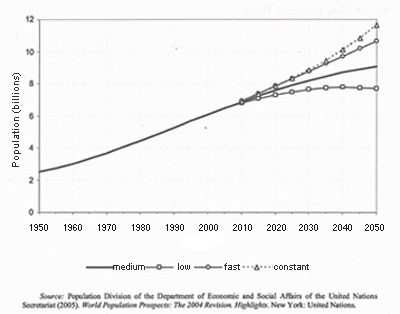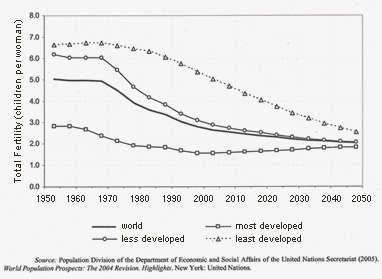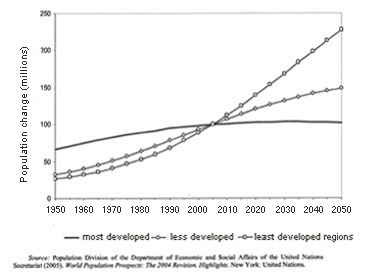

The world population at the beginning of the seventeenth century was approximately 500 million. Two hundred years later, that figure had doubled. It doubled again by 1920. By 1980, two billion had become four. Today, the world population stands at 7.1 billion and counting. At present reproductive rates, United Nations demographers say this number will maximize sometime in the second half of this century at a number near ten billion. What will cause this hypothesized population plateau? We all must hope it will be the result of a conscious human effort to stop our growth. It could just as easily be the press of natural resource limitations, economic contraction, or political coercion. With the added unknowns of global warming and peak oil, who knows, the human population may never reach eight billion.

In the mid-1960s, the population growth rate, fertility rate minus death rate, peaked at a 2.19 percent. In the intervening forty years of increased environmental and population awareness that number has been reduced to 1.14 percent. This should be further reduced to 0.5 percent for a viable zero population growth (ZPG). Today most world governments are committed to "replacement population" (2.1 children per woman) and an eventual ZPG.
It is generally believed that economic development is the way to responsible fertility rates. The theory of demographic transition says that development brings about societal wealth, populace education, and a gradual awareness for the necessity of planned parenting. This evolution has proven true for most of the developed world, western Europe, North America, Japan, New Zealand, and Australia. Though there is quite a way to go for the rest of the world, demographers feel that there will be a fertility transition for developing countries as their standards of living rise. Currently the fertility rate of the developed world is approximately 1.6 children per woman. In the least developed nations, it is over 5 children per woman. The world average is 2.6. Subtracting for the death rate, this adds 75 million more people to the planet each year.

One alternative to demographic transition is coercive birth control. This exists to some extent in China today. A third choice is a non-choice. That is allowing the population to merely bloom past the carrying capacity of the earth and allow resource shortages to substantially increase the death rate. We might label this "free market" Darwinism. One way or another, population equilibrium will eventually find a bio-social maximum, be it through a die off or conscious control.
In gross numbers, the developed world is home to 1.5 billion people, the developing world 5 billion. The population of the developing world, however, is growing about three times faster than that of the developed world. At the same time, the developed countries are using Earth's natural resources about three times faster than the developing countries (ten times per capita). Despite the huge inequity revealed here and what it might suggest about the future of the developing world's economic opportunities, there is clear expectation among the richer nations for rest of the world to harness their fertility rates in the next 25 to 35 years and stabilize the population at the projected 10 billion.

Included in this reasoning is the understanding that even should demographic transition bring about global replacement reproduction by the year 2030, and there is no guarantee of that, the world population would still continue to grow for some time afterward due to the irresistible force of "population momentum," defined in Ann and Paul Erhlich's book, The Population Explosion, as "the tendency of a previously growing population to keep expanding long after reproductive rates have been reduced," much like "a supertanker requires several miles to come to a stop after reversing its propellers." The reason for this is that at any time prior to a population entering into replacement reproduction, a high portion (30 to 45 percent) of the populace will be under the age of fifteen. "The bottom line on demographic momentum is simple: barring plunges in the birthrate that take family sizes well below replacement reproduction, or substantial rises in the death rate, it will take fifty or sixty years after a rapidly growing population reaches replacement reproduction to achieve ZPG."
Though there is wide debate on how or when, and even if, world populations will stabilize, if we accept the United Nations' assumptions as a working hypothesis, at some point during the next century, our number will maximize at a number approximately thirty percent higher than it is today. Since arable land is already at or near its viable limit, this means present crop yields per unit of land must also increase by thirty percent in the next fifty or seventy-five years to meet projected population gains. With grain harvests already maximized by vast inputs of nonrenewable petrochemicals and unsustainable farming methods, we're looking at the uncomfortable situation of more living with substantially less or something much more drastic.
When we look at the big picture, when we try to establish guidelines for stewardship of planet Earth as an engineering problem, human population is the key. While many of the variables, water, forests, fossil fuels, arable land, have geophysical limitation and offer critical parameters, human population is the only variable in the equation that impacts every other variable–meaning a conscious reduction of the number of humans to an optimum population is one way to relieve pressure on all critical resources. For moral, philosophical, and religious reasons, there is resistance to managing human population, even more so to reducing human population. When push comes to shove, however, either we take responsibility for our birth rate and lifestyle or forces beyond our control will.